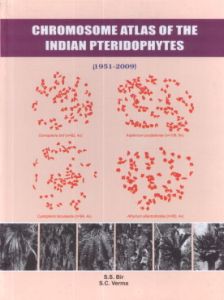
Contents: Frontispieces I-II. Imprimis. Acknowledgements. Forewords I-III. Introduction: 1. Pteridophytic vegetations in India. 2. Taxonomy of Indian pteridophytes. 3. Census of Indian pteridophytes. 4. Chromosome number and taxonomy. 5. Polyploidy and related issues. 6. Orthospecies and nothospecies. 7. Cytology of Indian pteridophytes. 8. The chromosome atlas. 9. Phytogeographic approach. Alphabetic listing of generic names. Lists of chromrsome numbers: I. Lycophytina (Lycopsida): Family: 1. Huperziaceae. 2. Family: Lycopodiaceae. 3. Family: Selaginellaceae. 4. Family: Isoetaceae. II. Sphenophytina (Sphenoepsida): Family: Equisetaceae. III. Psilophytina (Psilotopsida) Family: Psilotaceae. . IV. Filicophytina (Filicopsida): Family: 1. Helminthostachyaceae. 2. Botrychiaceae. 3. Ophioglossaceae. 4. Angiopteridaceae. 5. Maratticeae. 6. Osmandeceae. 7. Plagiogygriaceae. 8. Gleicheniaceae. 9. Grammitaceae. 10. Loxogrammaceae. 11. Polypodiaceae. 12. Dipteradeceae. 13. Schizacaceae. 14. Lygodiaceae. 15. Sinopteridaceae. 16. Cryptogrammaceae. 17. Actiniopteridaceae. 18. Pteridaceae. 19. Adiantaceae. 20. Hemionitidaceae. 21. Vittaraceae. . 22. Parkeriaceae. 23. Marsileaceae. 24. Hymenophyllaceae. 25. Cyatheaceae. 26. Dennstaeditiaceae. 27. Hypolepidaceae. 28. Lindsaeaceae. 29. Thelypteridaceae. 30. Aspleniaceae. 31. Onocleaceae. 32. Woodsiaceae. 33. Athyriaceae. 34. Aspidiaceae. 35. Lomariopsidaceae. 36. Elaphoglossaceae. 37. Nephrolepidaceae. 38. Oleandraceae. 39. Davalliaceae. 40. Blechnaceae. 41. Azollaceae. 42. Salviniaceae. Addendum. Application of cytological data in the understanding of evolutionary sequence and phylogeny of the Indian fern families and genera. Appendix: 1. Chromosome number reports of ferns of Pakistan. 2. Chromosome number reports of members of Pteris Linn. References. Index.
The present compilation of the chromosome atlas of the Indian pteridophytes is the first work on the subject concerning the recorded chromosome numbers of fern and fern allies investigated in Indian and that too by the Indian scientists. The data generated and nearly 100% available for the period 1951 to 2009 is included in the book.
It was in 1950-1951 the two centres of research on cytology of the Indian pteridophytes were established at Punjab and Kerala universities when a number of Ph.D. scholars were engaged on the chromosomal analysis of wild pteridophytic floras of the Himalayas and South Indian Mountains (Western ghats) respectively. Subsequently strong centres of cytology of pteridophytes were also established in the universities at Patiala, Patna, Pune etc. Time to time research papers started appearing on the results obtained about chromosome numbers in various Indian and foreign publications. The total information was recorded in the chromosome atlases published from Italy (Firenze) and Germany (Vauduz) but these included only the information about the chromosome numbers and about the bibliographic references.
When the present work was taken up in the year 2000, it was decided that information about the region, place and localities must be given for each species. Though the task was highly difficult to get an access to the original papers of the authors yet the goal was achieved and full information is provided in the present chromosome atlas. It is unique one in the world in its own category. Additionally, detailed information on cytological results is also provided where these are conflicting. Apart from nearly all the investigated regions of India, the chromosomal information is also provided for Pakistan, Nepal and Bhutan whose territorial areas constitute parts of the Himalayas.
In all 150 genera, 910 species and c. 1100 taxa are included in the text of the book. This makes about 90% of the total recorded pterodiophytic taxa from India. The present chromosome atlas should be highly useful to the future scientists who undertake research work on the genetic material of the vegetation composed of fern and fern allies. (jacket)